The 12 Best AR-15 Triggers Ranked [2024 Buyer’s Guide]
Are you looking for a new high-performance trigger for your AR-15, but you’re unsure about which one would best suit your build or style of shooting? We’ve got you covered!
If you’re in the market for a good match trigger, something with a short reset, or just a good budget option for your first build, we have plenty of recommendations on which triggers are the best.
We’ve added some additional info on trigger design, types, and the different aspects of each of the best AR-15 triggers on the market today to aid you in your search.
Exploring AR-15 Trigger Designs
An AR-15 trigger can significantly impact the shooting experience. Much like the upper receiver, triggers can vary greatly based on operator preference and intended use. For this reason, a trigger’s ergonometric specifications are painstakingly considered during its development in order to ensure a positive end-user experience.
Here is a basic breakdown of trigger components:

Additionally, it’s important to understand some of the common terminology used when discussing AR-15 triggers. You will often hear people discuss the take-up or creep of the trigger. Here is what that means.
Triggers are currently manufactured in two distinct configurations: straight/flat or curved. Each design offers its own unique advantages and drawbacks, which grants shooters a greater level of flexibility in their search to find a trigger that best compliments their style of shooting.
Many manufacturers will offer their triggers in both straight and curved forms.
Now, let’s break down the differences between these two trigger types.
Straight/Flat Triggers
Straight/flat triggers have gained popularity because of the consistency and leverage they provide in terms of the uniformity in the trigger pull.

Unlike with curved triggers, shooters rarely need to concern themselves with the strictures of finger placement when it comes to straight/flat triggers. Because this trigger design offers a consistent trigger pull, regardless of where finger engagement occurs, it further ensures a level of trigger control, accessibility, and accurate shot placement.
Basically, shooters find that straight/flat triggers offer a more precise and responsive feel, which allows for better trigger manipulation.
Curved Triggers
Curved triggers have long been the standard for many shooters because they are considered more comfortable due to their ergonomic shape. The specific uniform curve of the trigger also allows it to sit further back inside the trigger guard.

What’s more, the snug fit of the trigger’s curved design can be advantageous when shooting with gloves because it provides additional clearance and an easier access-point to the trigger.
For this reason, curved triggers continue to garner high praise for their traditional design and familiarity among seasoned shooters.
The choice between curved and flat triggers really comes down to personal preference. There’s no definitive universal trigger, as it depends on several factors including shooter hand-shape, comfort, and preferred style of shooting.
We recommend giving both trigger designs a try in order to determine which one has a more natural feel and can best serve your needs. Ultimately, finding the optimal AR trigger requires experimentation – hands-on experience is key in order to discover your preferred trigger design.
More for AR-15 Owners: Best AR-15 Handguards, Best AR-15 Upper Receivers, Best AR-15 Drop-In Triggers, AR-15 Buyer’s Guide
Single-Stage vs Two-Stage Triggers
Single-stage triggers are straightforward and have minimal take-up, which offers a more direct and immediate trigger pull. This type of trigger is most often found in the AR manufactured Mil-Spec configuration, and is known for its reliability and durability.
What’s more, single-stage triggers’ affordability and shooting applications are designed for specific situations where rapid target engagement is required, which is why it’s the preferred trigger design for military deployment.
Alternatively, two-stage triggers offer a distinct advantage when it comes to performance. For one, the combination of the take-up and the wall provide a precise tactile reaction that allows shooters to detect a consistent point-of-aim. This feature is particularly beneficial for precision shooting or situations that require deliberate trigger manipulation, such as, competition shooting or combat tactics.
The crisp break during the second stage ensures a predictable repeatability in trigger pull, which aids in accurate shot placement. Two-stage triggers, however, are more costly due to their complex design specifications. Additionally, the enhanced performance characteristics of a two-stage trigger make for a more challenging install.
Single-Stage Triggers:
There’s a few pro’s to single-stage triggers.
- Immediate Trigger Pull: Single-stage triggers have minimal take-up, which provides an immediate pull in one swift range of motion.
- Affordability: Single-stage triggers are generally less expensive than two-stage triggers, which make them more accessible to a wider range of shooters.
- Reliable and Durable: Mil-Spec single-stage triggers were originally designed for military use, so they are renowned for their reliability and durability among veterans and skilled shooters alike.
The downside is…
- Limited Trigger Control: The absence of a wall, or direct point of resistance, in single-stage triggers can negatively affect trigger pull and control, which can cause shot placement to be less precise under certain conditions.
- Potential for Creep: Some single-stage triggers may exhibit a slight amount of creep, which can affect the overall feel and consistency of predictable trigger pulls.
Two-Stage Triggers:
Pro’s of a two-stage trigger are:
- Enhanced Trigger Control: The two-stage design allows for better trigger control, especially in scenarios that call for precision shooting.
- Predictable Break: The precise break during the second stage provides a clear indication to shooters of when a round will be fired.
- Tactile Response: The first point on tension or “wall” during the first stage gives shooters a tactile reference point for consistent trigger pulls during follow-up shots.

The downside is…
- Higher Cost: Two-stage triggers are typically more expensive due to their enhanced design specs and higher level of performance.
- Additional Complexity: The trigger’s more complex two-stage mechanism may add a level of difficulty during the installation process, which can make routine maintenance slightly more of an involved process.
Marksmen with a traditional bent who seek simple design, resilience, and affordability may find a single-stage trigger more suitable. While those who prioritize precision shooting and a greater sense of trigger manipulation will opt for the two-stage variant.
In the end, the option of a single and a two-stage trigger will wholly depend upon your specific preferences and shooting style.
In other words, you do you.
Mil-Spec
Mil-spec or military-grade specification triggers usually come standard on the AR platform. As their name implies, these triggers have characteristics that are specific to defensive and tactical combat situations.
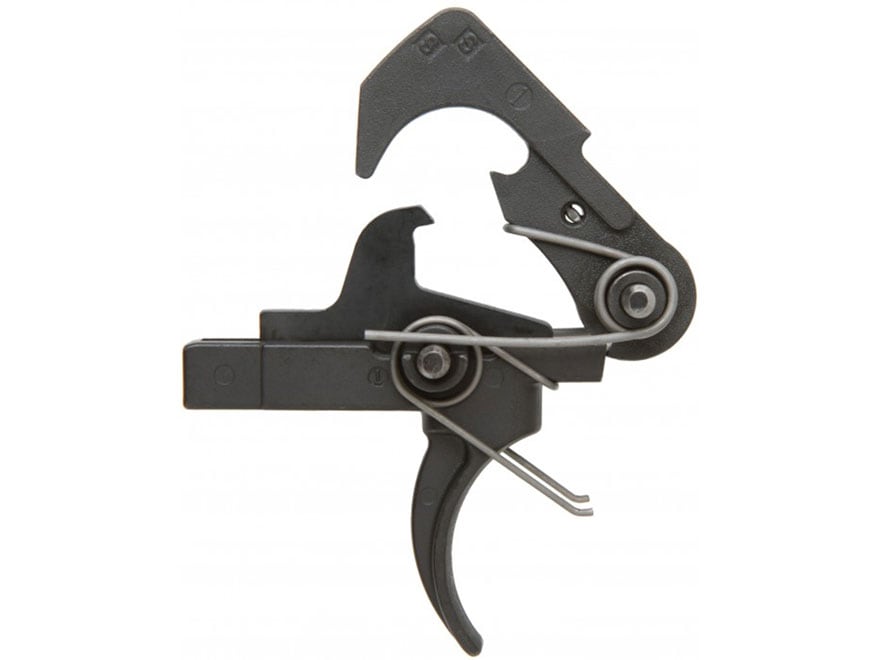
But, not all Mil-Spec triggers are the same because triggers that are specifically designated for law enforcement and military personnel have a heavier trigger pull weight ranging between 5.5 to 9-pounds of force to fire. This is a military feature that serves as a preventative measure against accidental fire.
Composite AR triggers that are designed for civilian use, however, possess a considerably lighter pull weight that falls between 2.5 to 4.5-pounds.
While Mil-Spec triggers possess a more traditional level of utility – it’s one that’s been consistently adopted by the U.S. Military, even today – which suggests that it’s a utility that shouldn’t be overlooked.
Drop-in
Drop-in triggers have become a worthy alternative to Mil-Spec because they differ greatly in both pull weight and trigger control. Drop-in triggers are designed to possess a lighter, more responsive, and predictable pull weight than that of composite triggers, which retain a grittier feel and an overall heavier trigger pull.
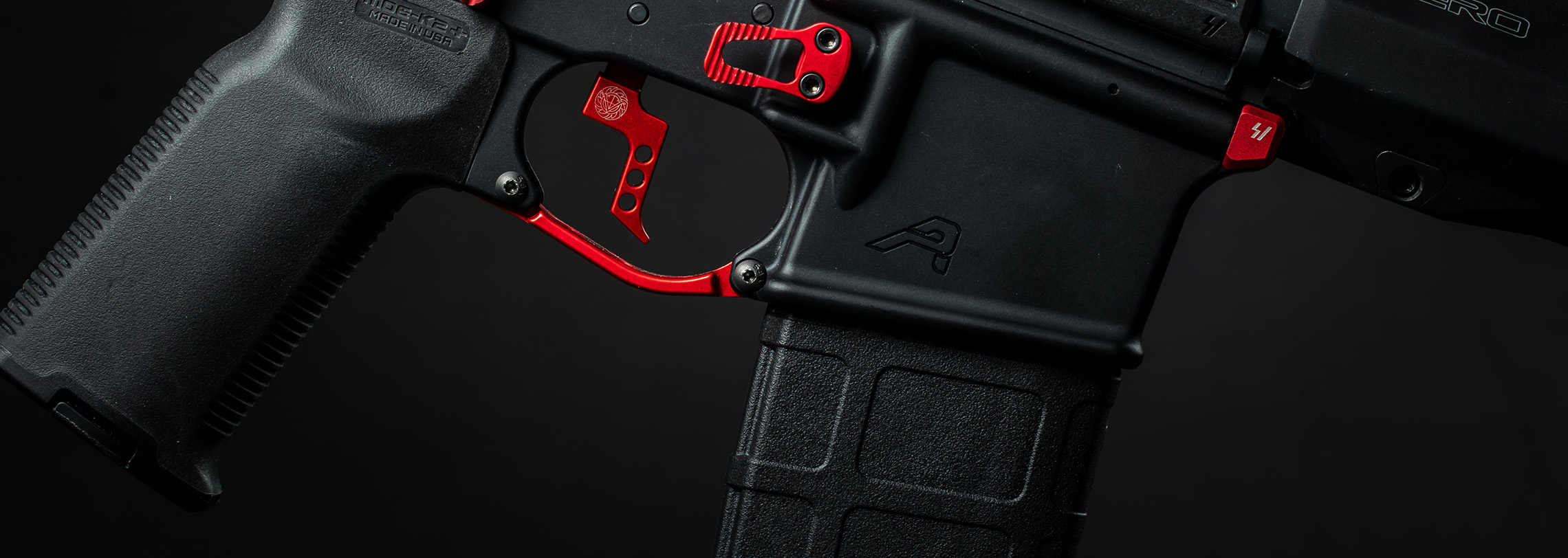
Drop-ins also come preassembled, which means there’s no need for additional component assembly or gunsmithing required. As their designation suggests, the drop-in maintains a straightforward installation consisting of a simple “drop” into a rifle’s lower receiver. Mil-Spec, however, requires some tinkering to attain a desirable pull weight.
Drop-ins are also more expensive than composite triggers, but they also have more inherent enhancements and better adjustability options on offer than Mil-Spec does. What’s more, certain drop-in triggers can be adjusted in either a single or a two-stage designation, which makes them a far more versatile and attractive buying option for shooters of all levels.

The Mil-Spec-faithful prefer the natural flexibility and feel of component triggers because the individual parts – springs, sears, hammers, etc. – can be mixed and matched. This feature provides a greater sense of exactness in terms of individual preference where pull weight is concerned.
The single unit drop-in trigger, however, has stringent manufacturer-specific parts that offer less variation due to its all-in-one design, which means that its innermost mechanisms cannot be easily swapped out without replacing the trigger outright.
And with that, let’s get to the list!
BEST OVERALL AR-15 TRIGGER: Geissele Super Semi-Automatic Enhanced

Geissele Super Semi-Automatic Enhanced
It’s no surprise to us that the Geissele Super Semi-Automatic Enhanced (SSA-E) trigger takes the top spot on our list. This semi-auto trigger was designed for precision shooting and combat situations. In fact, it’s actually a recalibrated variant of a full-auto two-stage trigger model used by the U.S. Armed Forces.
Brownells (See Price)
Primary Arms (See Price)
Sportsman’s Warehouse (See Price)
Although this two-stage trigger was specifically designed for Mil-Spec trigger groups, we found that it had a surprisingly balanced trigger pull between the first and second stage, which was equal parts light and heavy. What impressed us even more was that the SSA-E trigger only required about 3.5-pounds of force to fire, while maintaining that superb Geissele-signature feel.
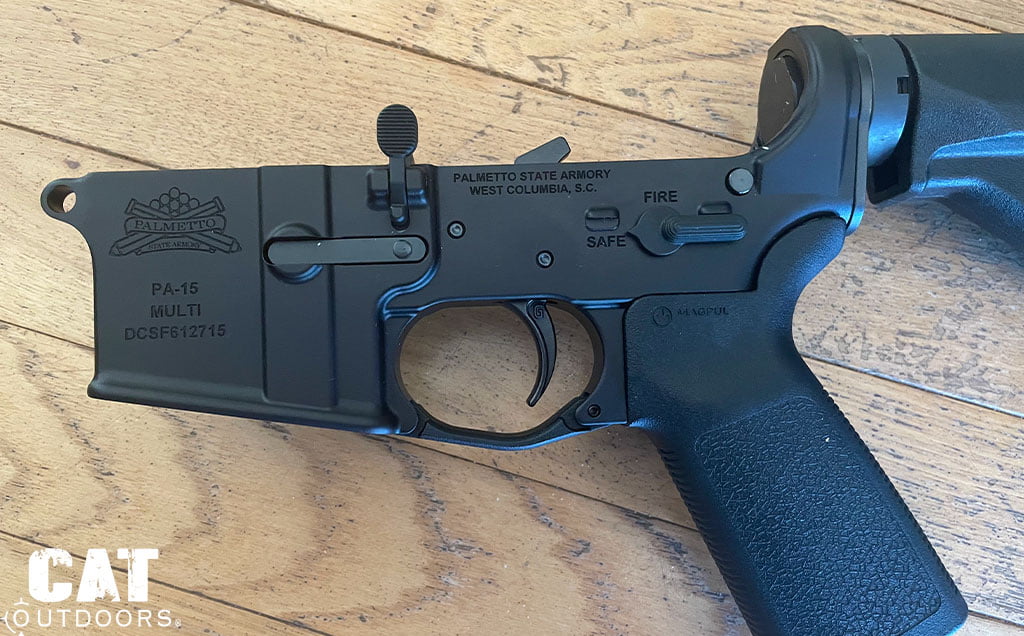
Pro’s:
- Two-Stage Design: The SSA-E is built in a two-stage designation. This trigger provides a precise breaking point, which greatly aids in shot accuracy and trigger control.
- Pull Weight: The firing pull weight of 3.5-pounds strikes a good balance between the initial sensation of heaviness for safety, while maintaining a lighter trigger pull during the second stage for more precise shooting.
- Consistent Quality: Geissele is known for the high quality craftsmanship and consistent performance of its triggers and components, the SSA-E trigger is no different.
- Smoothness and Sharp Break: The SSA-E trigger provides a smooth pull with a crisp break, which can enhance shooter accuracy and improve the overall experience.
Con’s:
- Premium Price Point: The SSA-E trigger is more expensive compared to most other AR-15 triggers. The higher price might put the Geissele Semi-Auto trigger out of reach for shooters on a tight budget.
- Non-Adjustable: The SSA-E is a non-adjustable trigger, which could be a considerable downside for shooters who prefer to fine-tune their trigger’s tensile strength.
- Complex Installation: The SSA-E trigger is not a drop-in design, so installation is a bit more complex. Novice shooters should seek out a licensed gunsmith for the most accurate install.
SPECIFICATIONS:
Type: Two-stage
Installation: Mil-Spec
Pull Weight: 3.5 lbs
Adjustable: No
Trigger Bow Type: Curved
BEST MULTIPURPOSE AR-15 TRIGGER: HiperFire EDT Sharp Shooter
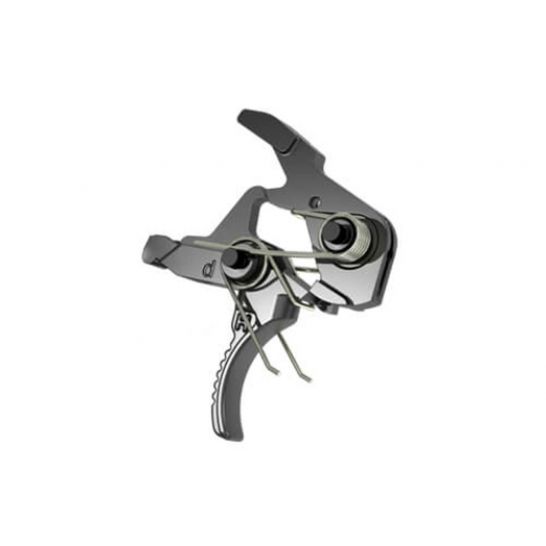
HiperFire EDT Sharp Shooter
The HiperFire Enhanced Duty Trigger (EDT) Sharp Shooter stands out as a noteworthy upgrade to the more traditional Mil-Spec style AR trigger in both design and performance. This single-stage trigger has earned our respect for its reliability, even though it’s a more budget-friendly option.
Palmetto State Armory (See Price)
Primary Arms (See Price)
Sportsman’s Warehouse (See Price)
And unlike most aftermarket triggers, the Sharp Shooter enjoys a multipurpose utility in that it can serve reliably in home defense, law enforcement, and competition shooting scenarios. The Hiperfire Sharp Shooter had a satisfying feel, a smooth pull, and a surprisingly stark break. Another plus for us was that the Sharp Shooter had an adjustable pull weight – from 4.5 and 5.5-pounds of force – which is rare in most single-stage composite designs.
Pro’s:
- Adjustable Pull Weight: The EDT Sharp Shooter’s kit comes with two interchangeable hammer springs, which allows for an adjustable trigger pull of either 4.5 lbs or 5.5 lbs.
- Value and Craftsmanship: The Sharp Shooter trigger is budget-friendly, which makes it a solid upgrade from the AR’s factory Mil-spec trigger without putting operators’ wallet in the financial hurt locker.
- Ease of Installation: The HiperFire EDT Sharp Shooter is generally an easy install, which is a big plus for shooters who gravitate towards complex installations.
Con’s:
- Adjustability is Limited: While the EDT Sharp Shooter offers an adjustable pull weight, it doesn’t offer the same level of adjustability that certain higher-end aftermarket triggers do, which has the tendency to give shooters reason for pause.
- Single-Stage Design: Shooters, particularly those interested in a more precise shooting experience, might prefer a two-stage trigger.
SPECIFICATIONS:
Type: Single-Stage
Installation: Mil-Spec
Pull Weight: Adjustable, 4.5 lbs and 5.5 lbs – two interchangeable hammer springs for pull weight adjustment
Trigger Bow Type: Curved
BEST ZERO TAKE-UP OPTION: Rise Armament Rave 140
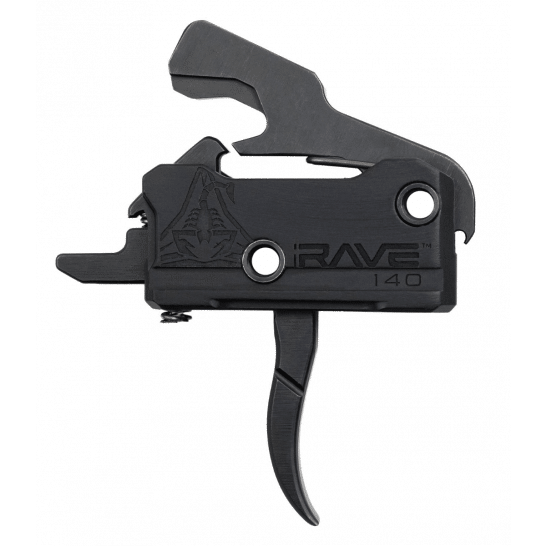
Rise Armament Rave 140
The Rave 140 AR-15 trigger is a single-stage drop-in from Rise Armament. The RA 140 has quickly become a go-to trigger for us for its satisfying pull weight, responsive performance, crisp release, swift reset, and tactile grip.
Brownells (See Price)
AR15 Discounts (See Price)
Primary Arms (See Price)
Another attribute to the RA 140 that we really liked was the elimination of take-up before engaging the sear, which aided in a faster, more predictable trigger pull. This zero take-up feature is a Rise Armament signature and comes standard on its entire roster of triggers – a lifetime warranty on all Rise triggers certainly can’t hurt either.
Pro’s:
- Clean Break and Zero Take-Up: The Rave 140 is known for its sharp break and zero take-up which can aid in shooting accuracy and a consistent trigger pull.
- Drop-In Design: As a drop-in trigger, it’s generally easier to install compared to Mil-Spec triggers, which is a great advantage for novice shooters who are unfamiliar with trigger installation.
- Crafted for Quality: The Rave 140 is built with high-quality steel, coated in black nitrite, and is precision machined, contributing to its reliability and durability.
- Monetary Value: The Rave 140 offers a significant performance improvement over a standard Mil-spec trigger and does so at a reasonable price, which make it a good value option for shooters looking to upgrade their factory-built AR-15 triggers.
Con’s:
- Non-Adjustable, Single-Stage Design: While two-stage triggers are naturally lighter and more suitable for precision shooting, the RA 140 is designed to be a heavier pull, single-stage, non-adjustable trigger.
- Potential for Pin Walk: Pin walk refers to the pins holding the trigger in place that gradually move out during use, but this is not so much a common issue anymore because anti-walk pins are included with the RA 140 kit.
SPECIFICATIONS:
Type: Single-Stage
Installation: Drop-In
Pull Weight: 3.5 lbs
Adjustable: No
Trigger Bow Type: Curved or Flat (depending on the model)
BEST ZERO CREEP OPTION: TriggerTech Diamond Single-Stage
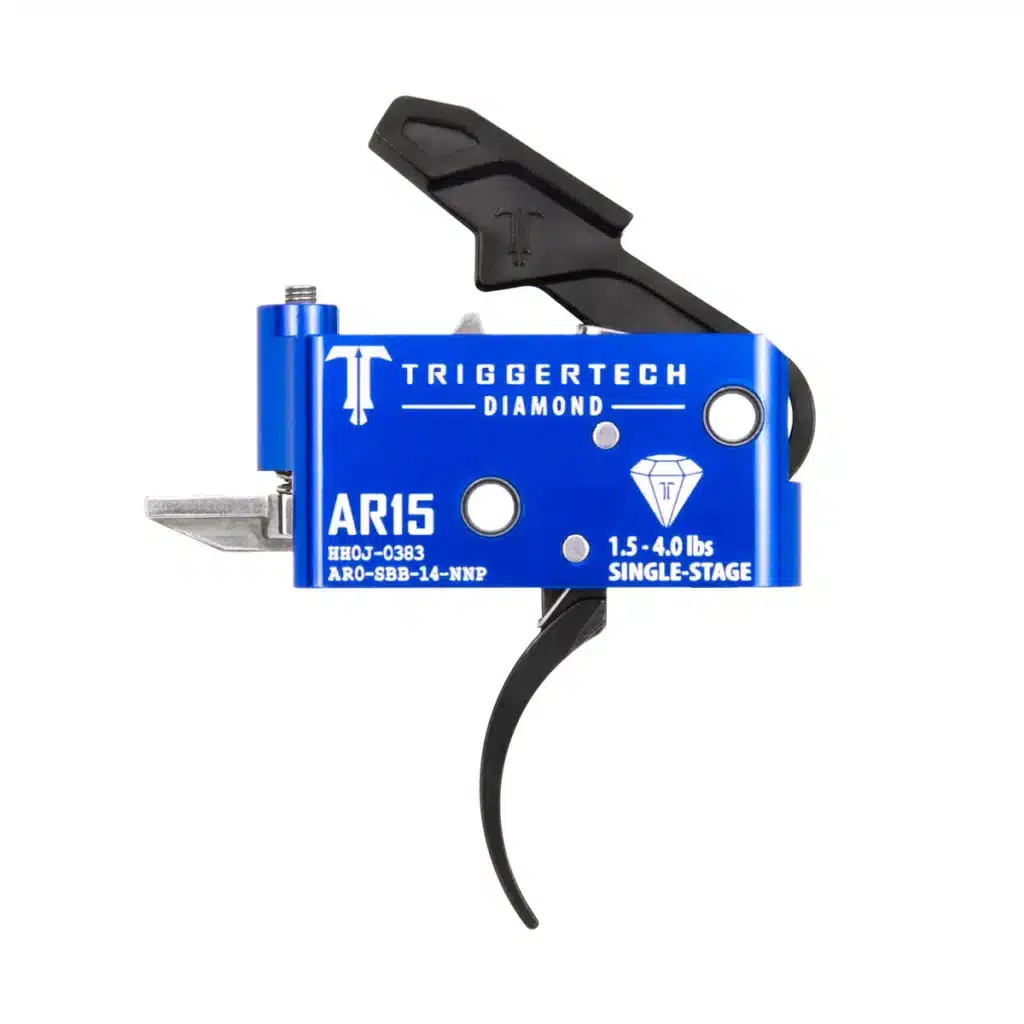
TriggerTech Diamond Single-Stage
The TriggerTech Diamond AR-15 trigger is a premium single-stage trigger known for its exceptional quality, unique release technology, and corrosion-preventing internals. This trigger was introduced in the latter-half of 2022, and is a variant of the two-stage AR model.
EuroOptic (See Price)
Palmetto State Armory (See Price)
The Diamond drop-in trigger’s design was inspired by, and built specifically for, competitive shooting. We’ve really taken to the Diamond’s frictionless, zero creep trigger pull, its improved tactile breakpoint is noticeably updated from previous models. What’s more, the Diamond’s equipped with a reactive reset in order to ensure quicker levels of fire and accuracy.
Pro’s:
- Adjustable: The Diamond drop-in’s pull weight is adjustable from 1.5 to 4-pounds, which allows shooters to fine-tune their trigger to a preferred setting.
- Frictionless Release Technology and Zero Creep: With the Diamond, like with most of TriggerTech’s roster of triggers before it, this unique anti-friction technology remains front and center and ensures zero creep and a palpable break. This TriggerTech-signature feature contributes to improved accuracy and consistency in shot placement.
- Durability: Made with high-quality materials and exceptional craftsmanship, this drop-in trigger is built to withstand heavy usage and harsh conditions.
Con’s:
- Price: While the high level of quality can account for cost, the Diamond may not fit every budget.
- Installation: Although it is considered a drop-in design, the installation process for the Diamond is slightly more complex compared to other drop-in triggers.
- Single-Stage Design: While the choice between single-stage and two-stage triggers largely comes down to personal preference, shooters might find that a two-stage trigger’s more measured approach more suitable.
SPECIFICATIONS:
Type: Single-Stage
Installation: Drop-In
Pull Weight: Adjustable from 1.5 to 4 lbs
Adjustable: Yes
Trigger Bow Type: Curved or Straight (depending on the model)
BEST COMPETITION TRIGGER: Timney Single-Stage Drop-In

Timney Single-Stage Drop-In
The Timney Single-Stage Drop-In trigger is known for its responsive pull weight, a stark break, and easy installation. Although this single-stage trigger is non-adjustable, we noticed no perceivable take-up or creep, which aided in overall feel and provided a faster reset.
Sportsman’s Warehouse (See Price)
EuroOptic (See Price)
Primary Arms (See Price)
These signature features are by design because the Timney single-stage drop-in is meant, first and foremost, to be a quick-reacting downrange or competition trigger, which further explains its light 3-pound pull.
Pro’s:
- Razor-sharp Break and Short Reset: Timney drop-in triggers are helpful during competitive or downrange shooting.
- Easy Installation: The Timney single-stage is designed to be easy to install.
- Reliability: Timney’s trigger components are rigorously tested for durability and built to last.
- Trigger Variety: Timney offers single-stage drop-ins in various pull weights, with either curved or straight trigger shoes, which allows shooters to better choose according to their preference in terms of feel.
Con’s:
- Price: While shooters can justify the higher price of Timney triggers from their precision machining and quality, they aren’t exactly budget-friendly.
- Non-Adjustable: While most drop-in triggers are known to offer a level of pull weight adjustment for preference, Timney’s single stage drop-in offers no such concession.
- Single-Stage Designation: While the single-stage model works for fast-paced competition, shooters might prefer a two-stage trigger, especially for its more measured shooting applications.
SPECIFICATIONS:
Type: Single-Stage
Installation: Drop-In
Pull Weight: Various models available, generally ranging from 3 to 4.5 lbs
Adjustable: No
Trigger Bow Type: Curved or Straight (depending on the model)
SHORTEST RESET TRIGGER: ATC AR Gold Drop-In

ATC AR Gold Drop-In
The ATC AR Gold Trigger is a high-end drop-in trigger system for the AR-15 platform that’s popular among competitive shooters for its excellent performance and drop-safe durability. The AR Gold single-stage drop-in trigger is adjustable between 2.5 and 3.75-pounds of force to account for shooter preference.
Brownells (See Price)
Rainier Arms (See Price)
AR15 Discounts (See Price)
With either level of adjustment, the AR Gold continuously maintained a light tensile strength, and reacted with a quick-action, clean break with each trigger pull. What’s more, the AR Gold drop-in sports one of the shortest reset configurations on the market today, which make it an attractive option for operators who desire a trigger that compliments repetitive firing scenarios.
Pro’s:
- Excellent Performance: The ATC AR Gold Trigger is renowned for its crisp break, no perceivable creep, and extremely short reset, all of which contribute to precise and fast follow-up shots.
- Adjustable: The trigger pull weight is factory-set at 3.5-pounds, but can adjust between 2.5 to 3.75-pounds using the provided springs, which offers greater flexibility for the end-user in terms of preference.
- Easy Installation: As drop-in designs go, the AR Gold’s installation is pretty straightforward, and requires minimal tools and time.
- Highly Durable: The trigger system is made from high-end materials and is designed to be robust and reliable, even under the most stringent demands of competitive shooting.
Con’s:
- Price: While the AR Gold’s performance might justify the cost for competitive shooters who demand the best, it may not fit into everyone’s budget.
- Fitting Issues: Minor fitting adjustments may be required during installation to ensure the perfect fit in the AR-15 lower receiver.
- Single-Stage Design: While single-stage triggers are preferred, especially in competitive or tactical contexts, shooters may prefer a two-stage trigger for its more measured trigger applications.
SPECIFICATIONS:
Type: Single-Stage
Installation: Drop-In
Pull Weight: Factory-set at 3.5 lbs (can be adjusted between 2.5 to 3.75 lbs)
Adjustable: Yes, with user-installed springs
Trigger Bow Type: Curved or Flat (depending on the model)
BEST VALUE TRIGGER: LaRue Tactical MBT-2S

LaRue Tactical MBT-2S
The LaRue Tactical MBT-2S (Meticulously Built Trigger – 2 Stage) is a high-quality aftermarket trigger designed for the AR-15 platform. As its name suggests, the MBT-2S is a two-stage trigger, which offers a distinct combination of responsiveness and control to better compliment a variety of shooting scenarios from target shooting, to hunting, to tactical defense.
GunMag Warehouse (See Price)
The total pull weight of the MBT-2S trigger is set at 4.5-pounds and is distributed between the two stages, which makes for a more balanced, responsive, and satisfying pull weight while simultaneously accounting for accurate shot placement and safety. Such quality of life enhancements only added to the MBT-2S’s charm and our shooting experience overall.
Pro’s:
- Two-Stage Design: The MBT-2S provides a distinct feel in terms of a ‘wall’ or breakpoint between the two stages, which is preferred for precision shooting.
- Workmanship: The MBT-2S is crafted using high-quality metal components and is impeccably machined for long life durability.
- Versatility: The MBT-2S is designed for a broad range of applicable shooting scenarios, which make it an excellent multi-purpose trigger – the LaRue MBT-2S delivers.
- Crisp Break and Reset: Shooters can expect a clean break followed by a swift reset, which can enhance shot precision and speed.
- Value for Money: While it’s not the cheapest trigger on the market, the MBT-2S provides a high level of performance at a moderate price point, and assures shooters that their hard-earned dollars aren’t being wasted on a flimsy product.
Con’s:
- Non-Adjustable: The MBT-2S has a fixed pull weight, which might not suit shooters who prefer to customize their trigger’s tensile strength.
- Installation Difficulty: While not overly complicated, installation is more involved than a drop-in, which might be a consideration for novice shooters who are less confident with firearms assembly processes.
- Limited Availability: LaRue triggers are currently in very high demand, which may result in backorders and longer wait times.
SPECIFICATIONS:
Type: Two-Stage
Installation: Mil-Spec
First Stage Weight: 2.5 lbs
Second Stage Weight: 2.0 lbs
Total Pull Weight: 4.5 lbs
Adjustable: No
Trigger Bow Type: Curved or Straight (depending on the model)
BEST TRIGGER FOR HOME DEFENSE: ALG Defense ACT

ALG Defense ACT Trigger
The ALG Defense Advanced Combat Trigger (ACT) is a high-quality, single-stage trigger that’s designed to be an upgrade over a standard Mil-Spec trigger. It’s known for its smooth pull and crisp break.
Optics Planet (See Price)
Primary Arms (See Price)
AT3 Tactical (See Price)
Rainier Arms (See Price)
Established in 2012 as a subsidiary of Geissele, ALG Defense emerged with a commitment to craft budget-friendly, high-quality triggers and components – one such creation is the Advanced Combat Trigger (ACT), which is an enhanced variant of the traditional Mil-Spec trigger. The ACT combines a comparable pull weight and a significantly smoother feel than the customary, prepackaged Mil-Spec triggers.
Moreover, the ACT elevates the overall shooting experience while remaining easy on the budget. The trigger and hammer are fabricated with an alloy steel finish, which ensures durability and protects against spring corrosion.
The ACT was host to a wide range of our different AR ammunition. And because the trigger’s pull weight sits at around 6-pounds of force to fire, it’s earned a spot on our list for its stellar defensive application capabilities.
Pro’s:
- Durability and Consistent Trigger Pull: The ACT is built with high-quality materials and craftsmanship, which ensures a smooth, consistent trigger pull and a clean break every time, which is a significant improvement over a standard Mil-Spec AR trigger.
- Lower Price: The ACT is reasonably priced, which makes it a cost-effective option for operators who are looking to upgrade their trigger’s performance without breaking the bank.
- Reliability: The ACT maintains the reliable function of a standard Mil-Spec trigger, but offers an improved trigger pull. This feature makes the ACT a more attractive option for marksmen who need a dependable trigger while on duty or for defensive use.
Con’s:
- Non Adjustable: The ACT does not offer an adjustable pull weight, which could be a considerable drawback for shooters who want more options in terms of customization.
- Single-Stage Design: While shooters prefer the simplicity and direct feel of a single-stage trigger, a two-stage trigger offers more shot variation in terms of precision shooting.
- Installation Issues: The ACT isn’t a drop-in trigger, so installation can prove to be more difficult because it requires disassembling and reassembling the lower receiver of your AR-15.
SPECIFICATIONS:
Type: Single-Stage
Installation: Mil-Spec
Pull Weight: 5.5 lbs
Adjustable: No
Trigger Bow Type: Curved
BEST SAFETY FEATURES: CMC Drop-In Triggers

CMC Drop-In Triggers
CMC Triggers is known for its high-quality, reliable drop-in trigger groups for the AR platform. They offer both single and two-stage models. Along with its satisfying trigger pull, little to no creep with a keen break, we saw that CMC designed their drop-in triggers with a sear overlap system that provides an extra level of safety.
Brownells (See Price)
AR15 Discounts (See Price)
Natchez Shooting (See Price)
AT3 Tactical (See Price)
This overlap feature is a CMC-signature enhancement that ensures the hammer will remain secure in the event that the rifle is in some way jarred or dropped, which reduces the chance for an unintended discharge. This feature could greatly aid novice shooters who are just learning the ropes at the range. Such careful design speaks to the level of quality craftsmanship behind CMC-brand triggers.
Pro’s:
- Variety of Choice: CMC Triggers offer both single-stage and two-stage triggers – with varying pull weights – and gives shooters a greater range of choice in determining the model that best fits their preferences.
- Ease of Installation: CMC’s simplified drop-in design makes the installation of the trigger group relatively easy, especially for novice shooters without much gunsmithing experience.
- Quality and Performance: CMC Triggers are well-regarded for their quality workmanship, consistency, and performance,which provide a striking breakpoint and a short, positive reset.
- Durable: Built with high-grade materials and encased in a sturdy aluminum housing, CMC triggers are built to withstand heavy use over time.
Con’s:
- Non-Adjustable: CMC triggers are not adjustable, which means preferred pull weight must be assessed at the time of purchase, which may not suit shooters who want the flexibility to adjust their trigger pull on the fly.
- Price Point: While they are made with quality in mind, CMC triggers are not the cheapest triggers on the market, and can be a point of consideration for shooters on a tight budget.
- Trigger Pin Issues: “Pin walk” has been a known issue with CMC triggers, but it’s not a common occurrence, and can be resolved with anti-walk pins.
SPECIFICATIONS:
Type: Single-Stage or Two-Stage (depending on the model)
Installation: Drop-In
Pull Weight: Various models available, generally ranging from 2.5 to 5 lbs
Adjustable: No
Trigger Bow Type: Curved or Flat (depending on the model)
BEST TRIGGER WITH ZERO OVERTRAVEL: PSA Custom Drop-In

PSA Custom Drop-In
This trigger offers a lighter pull weight of just 3.5-pounds and has a surprisingly acute breakpoint. We got a greater sense of feel with no overtravel between our initial trigger pulls from its point of fire to its short reset.
Palmetto State Armory (PSA) is well-known for producing a wide range of firearms and accessories. One such standout product is their single-stage custom drop-in trigger for the AR-15 platform.
Even better, this drop-in trigger is made from parts that are sourced and certified from right here in the U.S.
Pro’s:
- Easy Installation: As a drop-in trigger, installation is straightforward, making it an accessible upgrade even for those not comfortable with the more complex gunsmithing of Mil-Spec models.
- Improved Trigger Feel: The PSA Custom Drop-In offers a smoother pull and a responsive break compared to a standard Mil-Spec trigger, which improves shooting accuracy and overall experience.
- Affordable: PSA’s triggers are budget-friendly, which make them a solid option for shooters who want a significant performance upgrade in their trigger emptying their wallets.
- Quality Design: Affordability does not lessen the shooting experience, as PSA’s drop-in trigger offers a good balance of performance and durability for less.
Con’s:
- Non-Adjustable Trigger: The trigger pull weight is not adjustable, which might serve as a downgrade for shooters desiring a customizable trigger feel.
- Single-Stage Design: Shooters, particularly those focused on the quickness of precision shooting, might prefer the distinct feel of a two-stage trigger.
SPECIFICATIONS:
Type: Single-Stage
Installation: Drop-In
Pull Weight: Varies depending on the model, but commonly around 3.5 lbs
Adjustable: No
Trigger Bow Type: Curved
BEST TACTICAL TRIGGER: BCM PNT Trigger Assembly

Bravo Company PNT Trigger Assembly
The BCM PNT Trigger Assembly (Polished Nickel Teflon) is a single-stage Mil-Spec trigger system offered by Bravo Company USA. Like the Rock River Arms’ roster of triggers, BCM aims to bridge the gap between the standard AR Mil-Spec factory triggers and the high-end, premium aftermarket trigger systems.
Brownells (See Price)
Primary Arms (See Price)
Optics Planet (See Price)
Rainier Arms (See Price)
Natchez Shooting (See Price)
The PNT is, first and foremost, a combat trigger. As its name suggests, the PNT single-stage trigger is coated with a hardened nickel Teflon plating in order to shore up its durability and shot consistency during heavy use.
From its deliberate hardened look to its unadjustable hefty trigger pull, the PNT is designed for safety, stability, and able to withstand the rigors of a firefight. The BCM PNT is an ideal heavy-duty trigger for law enforcement and military personnel use.
Pro’s:
- Inherent Quality: BCM is renowned for their machining quality, and the PNT Trigger Assembly is no different, featuring a nickel Teflon coating to ensure a smooth performance and durability.
- Improved Feel: Despite being a Mil-Spec trigger, the polishing and coating process helps to provide a smoother, more consistent pull, and a cleaner break than the average Mil-Spec trigger.
- Built for Reliability: Like other BCM products, the PNT Trigger Assembly is built to withstand punishing conditions, while delivering a consistent level of performance.
- Budgetary Value: The PNT is a step-up from standard Mil-Spec triggers and provides an enhanced shooting experience without draining the bank account.
Con’s:
- No Adjustability: Similar to other Mil-Spec triggers of its kind, the BCM PNT doesn’t offer any wiggle room in terms of adjustability.
- Heavy Pull Weight: Although the PNT is an ideal option for its reliability in combat or defensive shooting, its heavy pull weight might stifle more precise styles of shooting.
- Not a Premium Trigger: While the PNT’s improved performance is a significant upgrade compared to factory-milled Mil-Spec triggers, it may not provide an ultra-smooth pull or satisfying break that premium aftermarket triggers are known for.
SPECIFICATIONS:
Type: Single Stage
Installation: Mil-Spec
Adjustability: No
Pull Weight: The pull weight ranges between 5.5 to 8.5-pounds, and adheres to standard military specifications.
Trigger Bow Type: Curved
BEST BUDGET OPTION: Rock River Arms Two-Stage Trigger
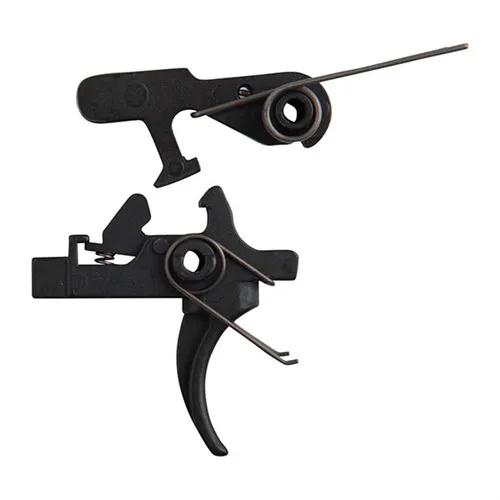
Rock River Arms Two-Stage Trigger
The Rock River Arms two-stage trigger has found a new home in many AR shooters’ builds in recent years. Known for its light, predictable trigger actuation and piercingly reliable breakpoint, it’s the RRA’s price that’s caused it to become a favorite among operators.
While being a non-adjustable trigger, like most composite models before it, the RRA two-stage is still a considerable upgrade compared to the prepackaged, factory AR triggers for its lighter trigger pull and noteworthy sense of feel.
The RRA is an average Mil-Spec trigger by design. Are there better triggers out there? Yes. But, it’s hard to compete with the amount of reliability that operators will get, and with a lower price tag.
Pro’s:
- Improved Accuracy: The two-stage nature of the trigger allows for a predictable and consistent pull, which can help increase accurate precision shooting.
- Quality Design: Rock River Arms is known for their solidly built components, and this trigger’s steel frame ensures durability and longevity.
- Smooth Operation: The pull remains smooth and clean, with a piercing break, and short reset.
- Budget Buy: For those looking for a two-stage trigger, this one offers a balance of quality and affordability because It’s generally less expensive than many other aftermarket triggers.
Con’s:
- Non-Adjustable: Like with most aftermarket Mil-Spec trigger groups, this RRA trigger doesn’t offer an adjustable pull weight to account for shooter preference.
- Installation: While not overly complicated, installation of the RRA two-stage trigger might require more adept gunsmithing knowledge because, unlike drop-in triggers, Mil-Spec triggers do not come pre-assembled.
- Finish Quality: Issues have arisen concerning the RRA trigger’s finish because it may wear faster over time than other aftermarket premium triggers.
SPECIFICATIONS:
Type: Two-Stage
Installation: Mil-Spec
Pull Weight: Approximately 4.5 lbs to 5 lbs (2 lbs on the first stage and 2.5 lbs to 3 lbs on the second stage)
Adjustable: No
Trigger Type: Curved
Final Thoughts
While we wanted to provide an expansive deep dive into triggers – in terms of their makes, stage configurations, and types – our guide is, by no means, exhaustive. Why? Because trigger manufacturing technology is changing every single day to better accommodate the shooting community and create a safer, more streamlined experience.
Like shooters, no two triggers are the same. Every trigger has its advantages, as well as its drawbacks. And because a uniformed, universal trigger has yet to be designed, we suggest that shooters experiment and go with a trigger that best suits their needs and shooting style. Truly, personal preference has and will always be king within the gun space.
Which trigger, stage configuration, and trigger type best suits your AR build and shooting style? Do you think other triggers should have made our list? Tell us all about it in the comments.

Aaron Basiliere is a staunch 2A advocate, a firearms researcher, and one of the principal content creators here at CAT Outdoors. He has written in multiple professional capacities for the last 16 years. He has a BA in English Writing from the University of Wisconsin. When not writing for CAT Outdoors he enjoys drinking coffee, watching documentaries, and spending time with his family and friends.

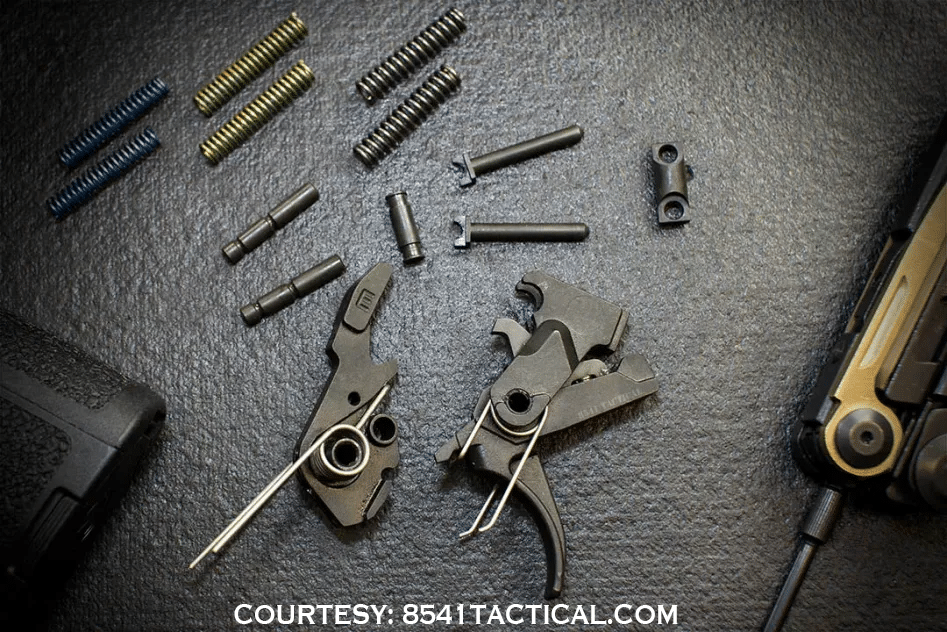



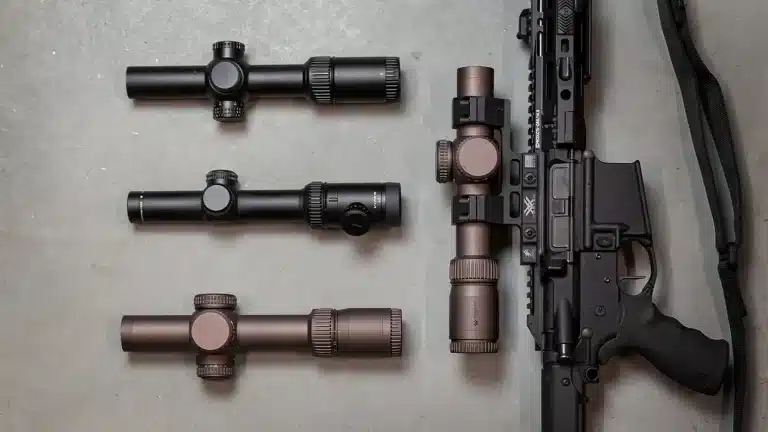
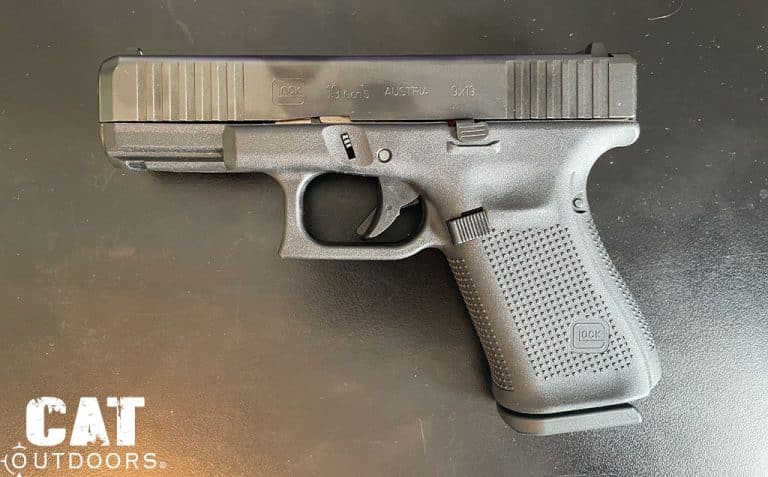


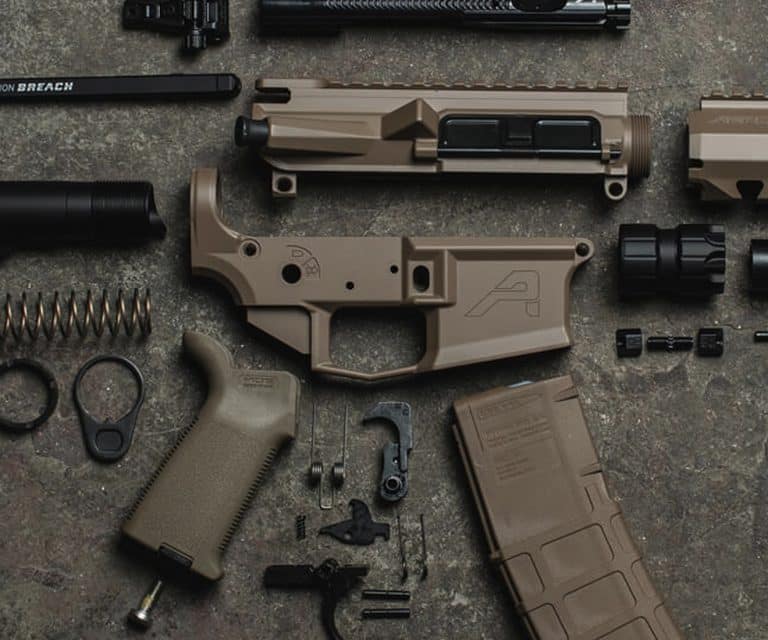
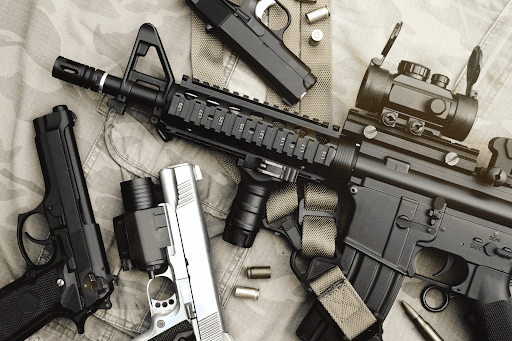


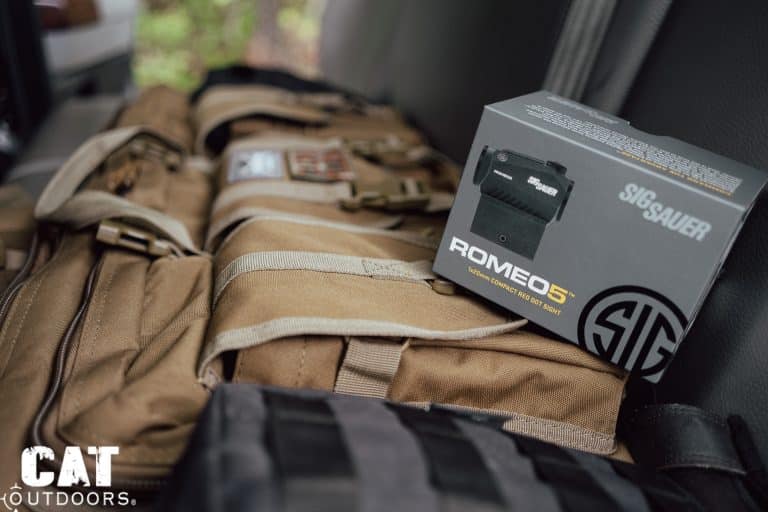
Rise makes much better triggers than the 140. Where are they?